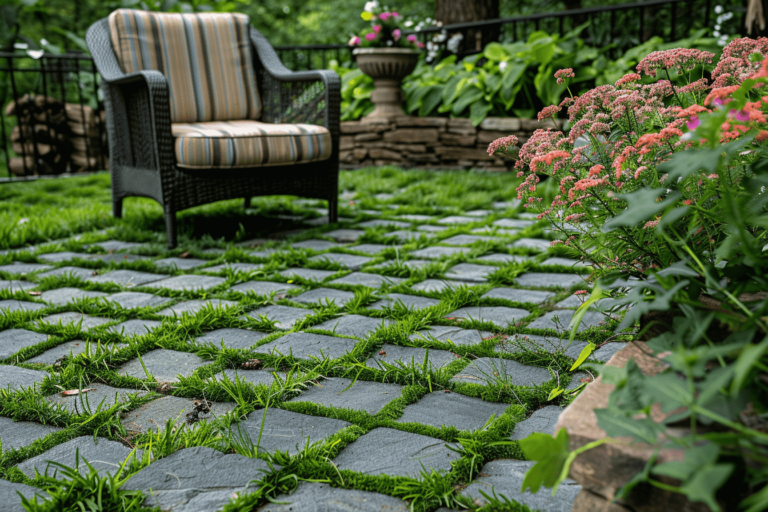How to Use Ferns for Ground Cover
Ferns can be primer proponents to fulfill the garden’s empty space with their lush, dense thick foliage appearances. If you have an empty garden space then look through the article properly.
In this article, I’ll exemplify how you can use ferns for your groundcover while elaborating on some points with you such as why ferns are best for ground cover, lists of space-filling ferns, and planting tips.
Moreover, I’ll conclude the paper by giving some pre-assembled situations where you can plant these ferns in your garden which will make your garden look attractive. So let’s go through the topic deeply.
Why Ferns Are Best for Filling the Garden Land
Ferns can be the best option to fill the garden land because it has dense foliage that can cover any yard and garden with their abdomen growth.
A dense layer of foliage can cover the low-level surface area of the garden which also gives the garden a beautiful wild look. That’s why ferns can be an excellent choice to make your garden’s look dense, thick and bushy.
Best Ferns for Ground Cover
Not all ferns are for ground cover. Some ferns can thrive indoors and some will thrive outdoors. Let’s look at some ferns that can be the best fit for your garden cover.
Royal Ferns

- Botanical name: Osmunda regalis
- Plants: Deciduous
- Native range: Europe, Asia and Africa
- Native habitats: Woodlands
- Shade requirements: full, partial, full sun
- Height: around 2.5 meters
- Soil: acid, neutral, alkaline, moist poor drainage tolerance
- USDA zone: 3-9
Royal Ferns are one of the wide-spreading ferns which wiwide-spreadingrden space very rapidly. They are also the most renowned ferns because of their beauty and pretty foliage.
They are also adaptable to wet ground and wet conditions which will make these ferns thrive in nature.
Additionally, during their early growth, it has purple fronds which later transfer from purple to green and green to golden brown throughout the years.
The unique coloration of their growing phase makes these excellent ground cover pretty ferns.
Cinnamon Fern
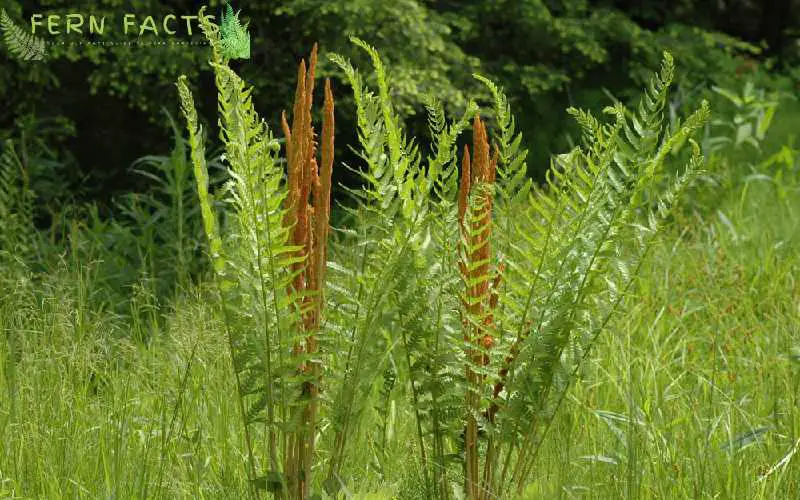
- Botanic name: Osmundastrum Cinnamomum
- Plant: Perennial
- Soil: acidic soil, clay, sand, well-drained, moist
- Light: full to partial shade
- Height: around 1 to 3 ft
- Width: around 2 to 3 ft
- USDA Zone: 3-9
Cinnamon ferns are known as space-filling ferns in any garden and yard. Similarly, the bright green color of softened foliage makes them more appealing.
As these ferns’ preferred habitats are woodlands, bogs, and swamps, therefore, they would be another best choice for ground cover.
These fern can grow up to 2 ft to 4 ft long along with their arched green foliage. As they are deciduous plants or perennial plants, they grow and shine during the summer seasons, and turn yellow before dying in the winter seasons.
Ostrich Ferns
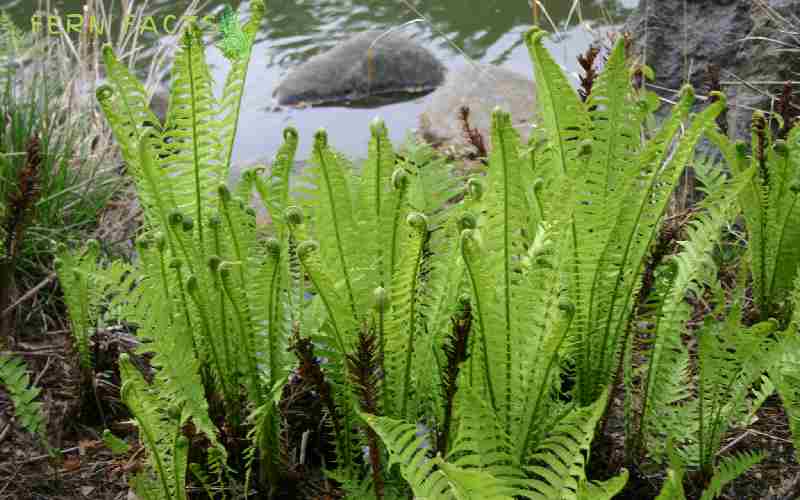
- Botanical name: Matteuccia struthiopteris
- Plants: Deciduous perennial
- Shade: partial or fully shaded
- Height: around 3 to 8 ft
- Width: up to 3-5 ft
- Soil: acidic soil (5- 6)ph, moist, organic matter
- USDA zone: 3, 4, 5, 6, 7
Ostrich ferns are another deciduous plant which have crown shape or colony forming ferns. Their colony-forming shapes give the garden a bushy appearance.
Additionally their vertical crown shape growing habits made them the king ferns of the ground. As they are deciduous fern, they lose their fronds during the winter seasons.
Especially during extreme winter and cold seasons, they need to be protected otherwise their situation will be more vulnerable.
Hay-Scented Fern
- Botanical name: Dennstaedtia punctilobula
- Plants: Deciduous plants
- Regions: eastern North America, Newfoundland, Wisconsin, Arkansas
- Habitats: woods or open woods
- Shade requirements: full or partial shade
- Height: around 1 meter
- Soil: acid or neutral, moisture, well-drained, adaptable with dry soil
Hay-scented ferns are also attractive ground cover ferns for any land and yard. They are invasive plants which means their growth will be spreading very rapidly.
As they have a quick tendency to spread therefore they are also one of the chosen ferns which will be the best suited for covering garden space.
Similarly, these hay-scented plants give nice fresh smells or aromas after being cut, which smells like freshly cut grass.
However, you can plant these ferns in your garden, still remember you need to prune and groom these ferns from time to time; otherwise they can harm other plants in your garden due to their excessive growth.
Japanese Painted Ferns
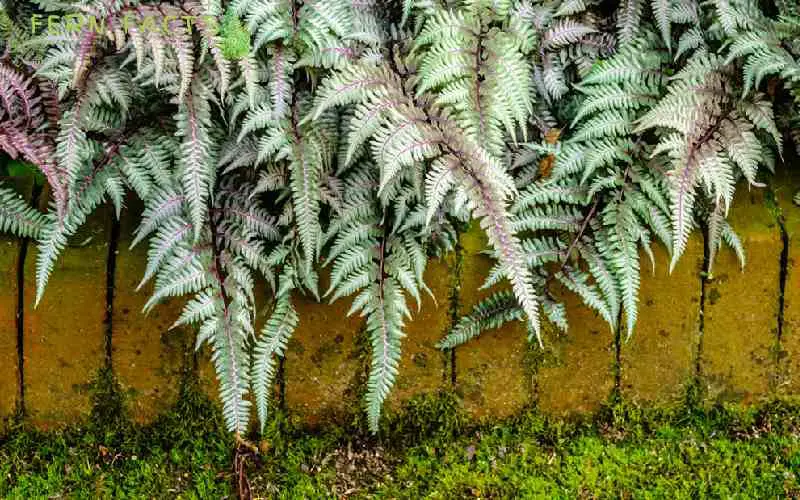
- Botanic name: Athyrium niponicum
- Plant type: deciduous perennial
- Size: around 1-3 ft tall, 1-2 ft wide
- light: bright and indirect sunlight or partial sunlight
- Soil: neutral acidic, alkaline, moist well drained
- Temperature: 50- 80 F
- USDA zone: 4,5,6,7,8,
Japanese-painted ferns are also deciduous ferns and are known for their slow-growing tendency. These ferns will also be the best option for ground cover in the garden.
As they have slow growth, their fronds can grow a maximum of 30 to 75 cm long. It will also give a nice color centric view because of their beautiful fronds.
These also spread with their low growing tendency and can form a cluster with their neighbor plants.
Although it will take several years because of their slow growth, once they are fully mature plants the garden’s look will be more attractive.
Holly Ferns
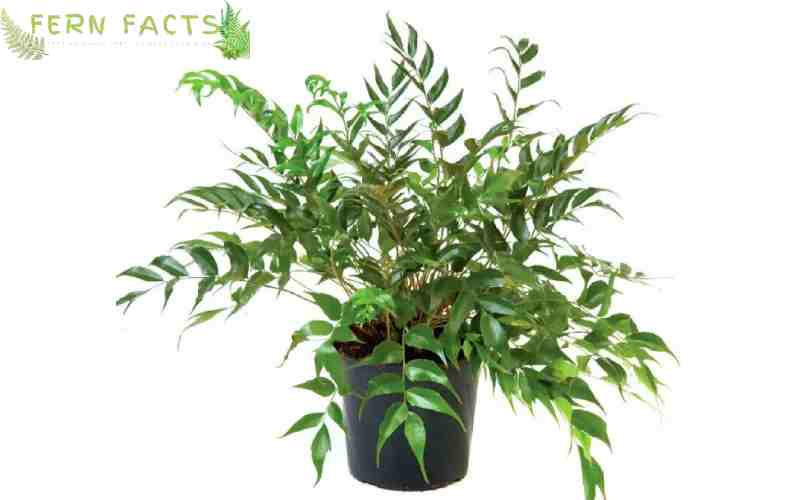
- Botanic name : Cyrtomium falcatum
- Plant: Perennial Semi-evergreen
- Height: around 18 to 24 inches
- Width: 24 to 36 inches
- Shade: partial shade or full shade
- Soil: well-drained
- USDA zone: 6,7,8,9
Japanese Holly ferns have glossy dark green lush appearances of holly branches. Their holly lush appearances are the finest option for ground cover.
However, they are perennial semi-evergreen ferns which means they lose their fronds for a shorter period. But they will regain their look during their growing seasons.
Planting Tips and Care
Maximum ferns are fond of loamy soil which has rich organic matter. That’s why you need to take some time to prepare and improve the soil condition of your garden.
Before planting the ferns, you can loosen the soil by any garden tools, then mix compost or any pear moss there.
Additionally, try to balance the ph level of the soil as most of the ferns prefer acidic soil or neutral soil. Try to give them the best soil condition so that ferns can get natural habitat.
Similarly, some ferns prefer indirect sunlight and some can tolerate the sun as long as their roots are well-hydrated.
That’s why, try to keep the soil well hydrated along with keeping the balanced humidity and temperature as well.
Where to Plant Your Ferns in Your Garden
Ferns are very beautiful and elegant ferns if they get enough environment for thriving. Here, I am sharing some tips and suggestions for you so that you can plant accordingly for ground cover.
Corner Borders
Ferns can bring rich wilderness by their naturalistic appearances. They can look good in any corner of the garden. That’s why you can plant them in any corner of the garden which will create a natural view in your garden.
Additionally, you can have multiple ferns in a row to have a bushy display of greenery foliage in your house. Alternatively, you can also use other shade loving plants like hostas, caladiums and astilbes to create bushy lush appearances in your house.
Below Tree Canopies
Ferns will be grown at their best under any tree’s canopy. This will give your garden low ground coverage look as well.
For this, wintergreen ferns are an excellent choice as they can tolerate drought more than other deciduous ferns which die away in winter seasons.
Near Water
If you have any waterpool in your garden, then ferns will be one of the best ferns to plant near the water. This will create an artistic view of your garden.
If you do not have any water or ponds in your garden, you can buy a mini waterfall for your garden and plan your ferns next to it.
As most ferns are fond of moist, damp environments, planting your ferns near a waterfall could be an appropriate place for them. Thus, it will give them a natural habitat and make them hydrated all the time.
Garden Pathways
Similarly, you can plant these ferns besides the path of your garden and make effective use of these ferns.
However, try to put a little gap between each plant so that they can be accommodated well and thrive fully.
You can put a minimum 3 or 4 inch gap to each ferns, so that when these ferns get mature they can get enough space therefore no plants will overshadow other plants in the garden.
Hence, it will give traditional brick pathways an appearance.
Cover the Problem Areas of the Garden
Many gardens have some sort of problem areas that somehow ruin the garden’s overall view. Therefore, you can plant ferns to cover those problematic areas of your lawn or garden.
For instance, you can prepare the soil properly with all organic matter and then plant the ferns there. In such cases, low growing ferns can be best for your garden as they need less attention after being established properly.
Recap
In the final observation, ferns are the finest option for ground cover in any garden and yard in order to fill the empty spaces. Ferns can make the garden’s look more appealing by their lush, dense view.
For instance, ferns like royal ferns, cinnamon ferns, painted ferns, holly ferns, hay-scented ferns could be the best option for filling the ground space.
Additionally, by placing them differently in the garden you can attract the natural wilderness into your garden.


